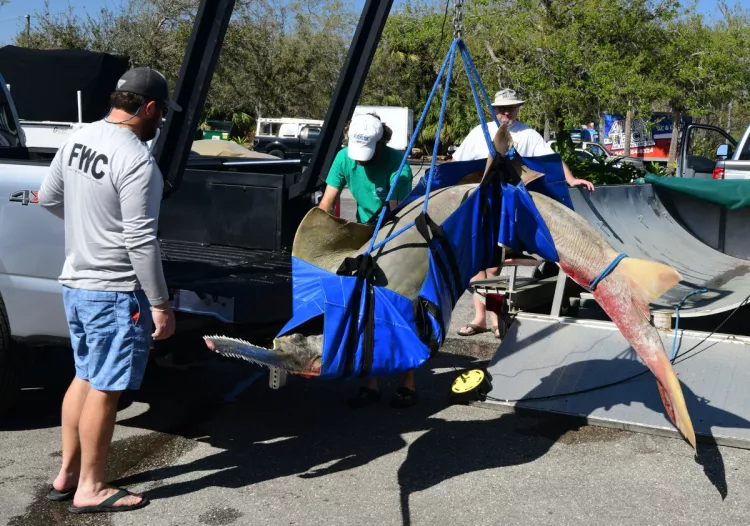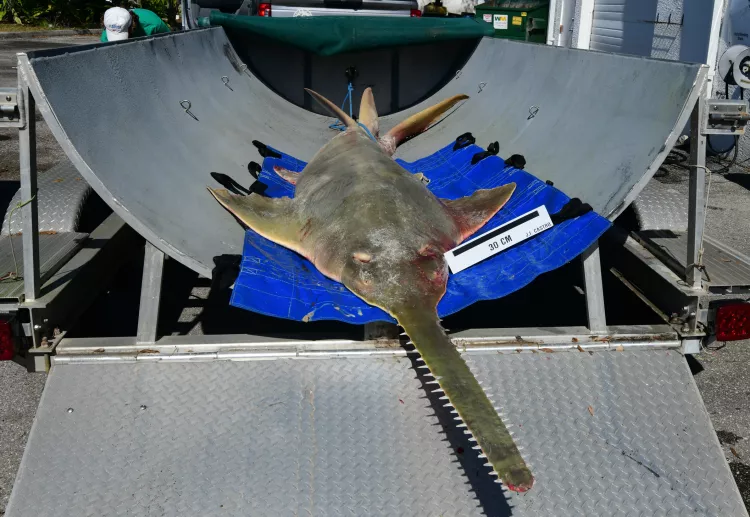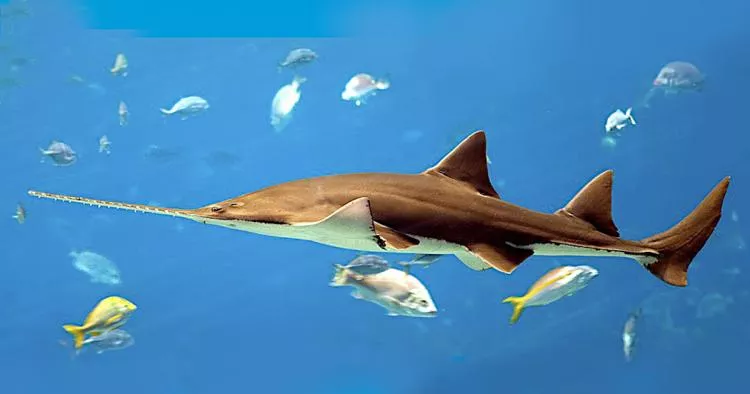Mysterious Sawfish Strandings Baffle Scientists in the Florida Keys
In an unprecedented phenomenon, sawfish, often referred to as carpenter sharks, are stranding themselves in shallow waters across a significant expanse of the Florida Keys. Reports have documented a startling twenty-eight of these majestic creatures struggling and dying in shallow waters. Yet there are no visible signs of illness or injury. The sawfish have been found in seemingly good condition, deepening the mystery surrounding their demise.
Sawfish, recognized for their distinctive long, narrow, flattened rostrum lined with teeth resembling a saw, are among the largest fish species. Often referred to as the “living fossils” of the ocean, they have long been shrouded in mystery due to their elusive nature and unique appearance.
The sawfish’s rostrum is not merely a weapon for self-defence but also serves as a specialized tool for hunting. It allows the sawfish to slash through schools of fish with remarkable precision, showcasing a unique hunting technique that has evolved over the millennia.
In addition to their hunting prowess, sawfish play a crucial role in maintaining the ecological balance of their habitats. Their presence in various ecosystems has a cascading effect on the populations of smaller fish, contributing to the overall health of marine environments.
Dr. Gregg R. Poulakis, a researcher with the Fish and Wildlife Research Institute (FWRI) and his team, are diligently conducting necropsies on the stranded sawfish in an attempt to unravel the mystery.

Sawfish being weighed at FWRI
Dr. José I. Castro, researcher at National Oceanic and Atmospheric Administration (NOAA) National Marine Fisheries Service, has joined them. He reports that the largest sawfish so far was a mature male of nearly fourteen feet (423cm) in length, and over 600 lbs (275 kg), that was found struggling in shallow water. But the only marks on the animal were freshly broken rostral teeth, obviously damaged by its struggles in the coral and sand.
Dr. Castro reported a peculiar observation in one female sawfish—an unusually heavy infestation of nematodes in the lower uterus. However, he specified, in sharks, a few nematodes are often found in the uterus and while this finding is unusual, the presence of nematodes alone would not be expected to cause the demise of such a robust animal.
The conundrum deepens as no harmful water conditions have been identified. However, reports of sick or deceased fish from more than two dozen other species have surfaced. Dr. Castro speculates that the cause may be an algal bloom, given the mortality patterns, elevated air and water temperatures, and the extensive geographical area affected. Toxicology reports are eagerly awaited to confirm or dispel this hypothesis.
Sawfish are slightly negatively buoyant, meaning that they are prone to sinking. For this reason Dr. Castro fears that those few found in shallow waters may represent only a fraction of the true numbers affected, for those that succumbed in deep waters would sink and be very unlikely to wash into shore. Therefore, sawfish mortality could be very extensive, the full magnitude of which remains unknown.
The herculean task of retrieving these enormous and heavy fish from shallow waters for necropsies is further complicated by the lack of proper facilities. The institute where the research is based lacks a necropsy facility for such large animals, forcing the team to conduct examinations in the parking lot adjacent to their offices, shielded only by a portable sun shade.

Sawfish being prepared for necropsy
Dr. Castro emphasizes the significant impact of these mortalities on the population recovery of sawfish, an already scarce species due to overfishing, but now protected by law. He says that little is known about them because they were not studied when they were plentiful. Though they are often tagged by scientists these days, such tags only reveal movement patterns. For these reasons, Dr. Castro writes, “These sad mortalities are contributing greatly to our knowledge of these magnificent fishes. The death of all these animals and the loss of the future generation are going to impact the population recovery of the sawfish.”
The loss of the iconic creatures raises concerns not only for their immediate conservation but also for the broader understanding of their behaviour and ecology. As scientists continue to grapple with the mystery surrounding their deaths, the need for conservation efforts to protect them and their habitats becomes increasingly urgent. The fate of the sawfish serves as a poignant reminder of the delicate balance between human activities and the natural world.
























